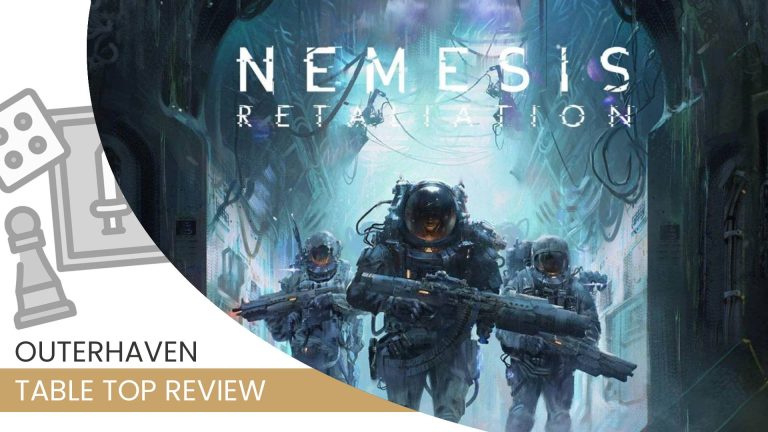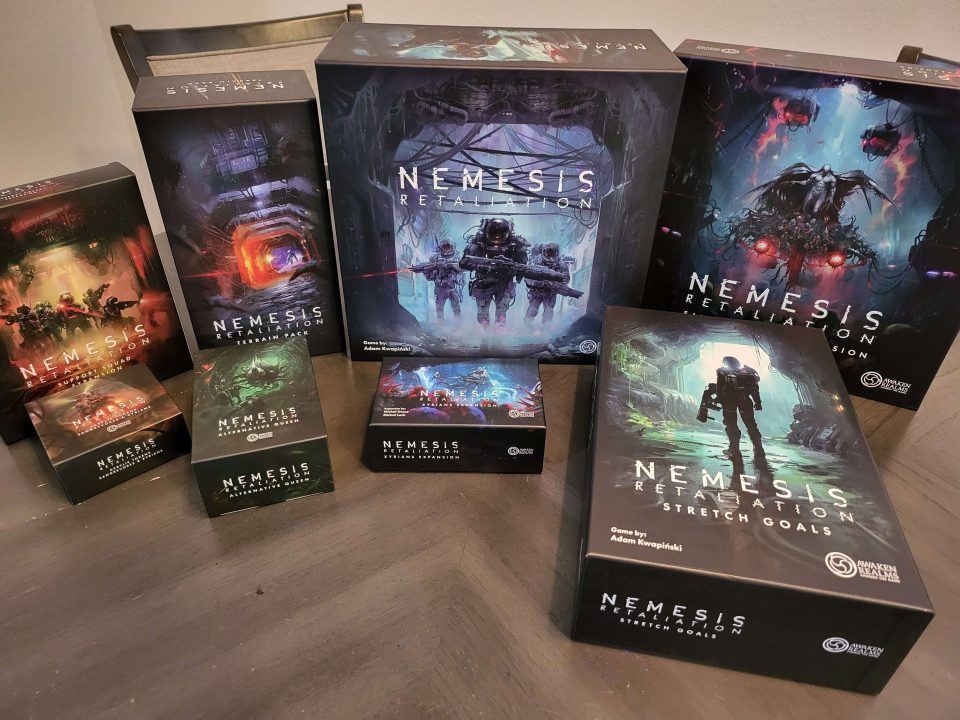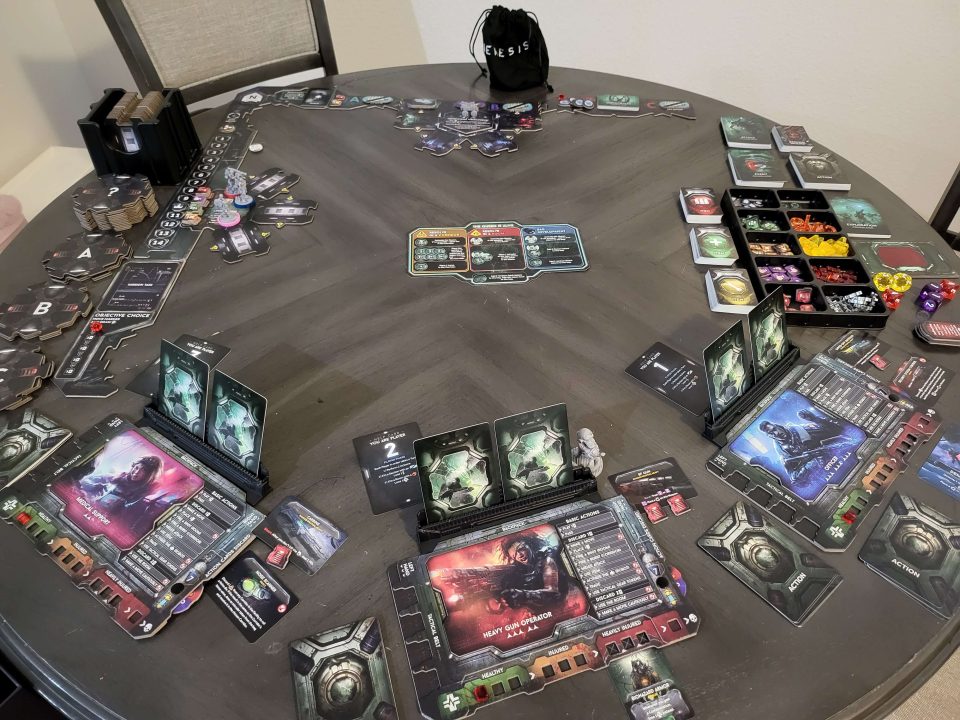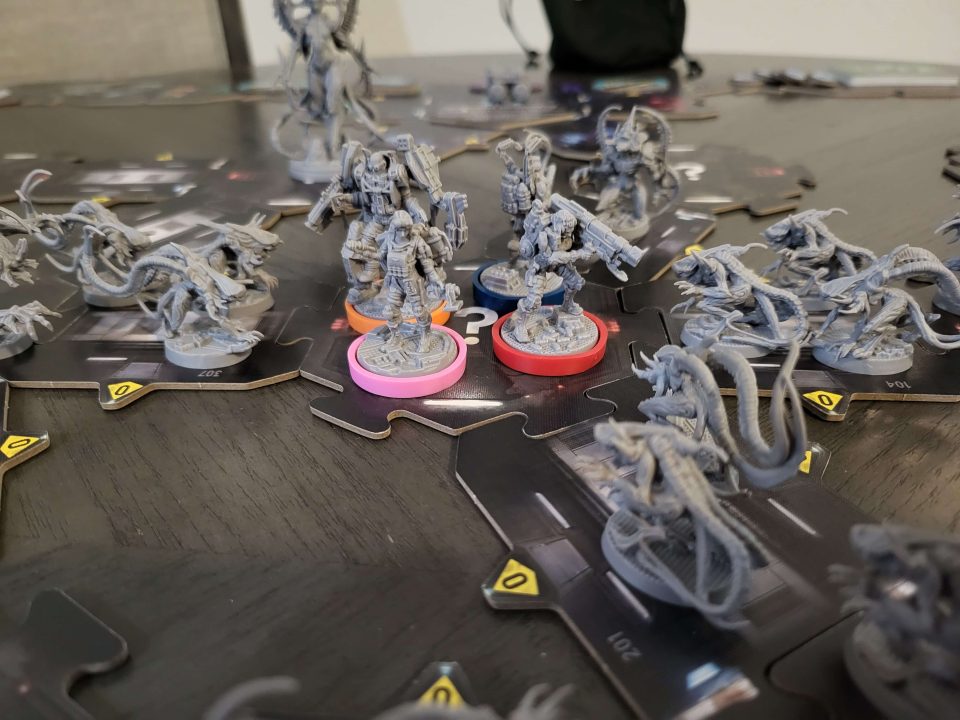Seven years after the first scream echoed through the Nemesis, the survivors have stopped running. This time, we’re not drifting in space or trapped on Mars – we’re bringing the fight to the nightmare. Nemesis: Retaliation closes the trilogy not with a whisper of terror, but with the roar of a squad kicking in the hatch, rifles drawn, hearts pounding.
For a franchise built on paranoia and panic, it’s almost poetic: fear has evolved into fury. You can smell the gun powder, feel the tension in the air, and hear the voice in your head whisper: “You think you’re ready, soldier. You’re not.”
Publisher: Awaken Realms
Designer: Adam Kwapiński
Players: 1-5
Playtime: 120-180
Genre: Sci-Fi Tactical Horror, Semi-Cooperative / Standalone
Release: Backer fulfillment 2025, retail still TBD
Overview
Retaliation reimagines the Nemesis formula through the lens of an action-horror finale. You’re no longer a helpless crew; this time, you’re a military strike team sent to clean up the mess the previous two games left behind. It’s also a standalone title, like the others, but it retains the trilogy’s DNA: asymmetric roles, semi-cooperative tension, and those “stab someone in the back” personal objectives.
Your mission begins the same way it always does: something goes wrong before the first turn. Communication blackouts, flickering lights, sealed bulkheads. The “strike” turns into “survive” before the first corpse cools. Where the first Nemesis asked, “Can you survive?”, and Lockdown asked, “Can you adapt?”, Retaliation demands, “Can you finish this?”
Mechanics & Flow
The familiar card-driven core returns, but now sits beneath a leaner, more kinetic framework. Turns feel sharper, objectives cleaner, and the downtime trimmed without losing tension.
- Key Mechanics & What’s New
Each player commands a specialist: Heavy Gunner, Medic, Recon – with unique loadouts and abilities. Actions feel tactical, not reactionary. The life bar is much more user-friendly. The Tactical Belt is a great addition to make you feel like Batman with its 4 slots for ammo, grenades, and more.
- Dynamic Enemy Behavior: Intruders respond to your aggression. The more noise and gunfire, the faster they mutate and flank. You can have 5 dropped in a corridor right behind you, think Zerg swarm.
- Mission Events: The board fights back – alarms trigger, systems melt down, corridors flood with fire. Every draw makes you change the mission on the fly.
- Tactical Map Redesign: The facility is modular, built from three sectors that shift with every playthrough. Routes open, collapse, or burn out – every map feels like a new battlefield.
- Streamlined Item System: Gone are the endless deck searches – essentially, you go in armed and ready.
The end result? You feel capable, but still never safe.
Combat is smoother, decision-making faster, and the dread hits in waves rather than walls.
Where the first Nemesis punished indecision, Retaliation punishes confidence.
Theme & Components
If Nemesis looked like Alien and Lockdown like Alien 3, then Retaliation is Aliens (arguably the best one).
The aesthetic is militarized horror – gunmetal corridors, industrial lighting, key landing zone, and the constant pulse of motion sensors echoing through the map.

The board is a dual-layer composite that supports the shifting mission system. Tiles flip, objectives rotate, and debris spreads visually across the area.
It’s cinematic chaos in plastic and cardboard.
Production-wise, this is Awaken Realms at their peak: no game table feels big enough (mine is way too small), and yet it’s all surprisingly usable.
Setup still takes time, but the organization trays and dedicated playerboards make it faster than its predecessors.
This is the first Nemesis entry that looks like a war and feels like a movie.
Ease of learning/Accessibility
Despite the spectacle, Retaliation is shockingly accessible.
The rulebook reads like a refinement manual rather than a rewrite – clearer layout, smoother examples, and visual flowcharts that make it finally possible to teach the game without coffee and despair.
New players can start here comfortably. Veterans will appreciate how many small pain points from the first two games were polished away: contamination steps, movement rules, and event resolutions are now second nature.
Difficulty remains medium-high, but understandable.
It’s still Nemesis – you’ll die, you’ll argue – but you’ll actually jump into the fight without fumbling through the rulebook.
The Table Experience
If Nemesis was fear and Lockdown was tension, Retaliation is momentum.
It’s the difference between screaming while you run and screaming while you charge. That fight or flight people struggle with.
The squad dynamics amplify everything: players shout over each other, coordinate overlapping fire arcs, and debate whether to burn the corridor or seal it.
Then the lights flicker, alarms wail, and your Medic gets dragged away mid-sentence. The semi-cooperative system still breeds mistrust. Personal objectives ensure you’re never fully aligned, and one “classified order” can flip an entire mission.
The difference is tone: instead of dread, it’s righteous chaos. You want to fight, even as the odds crush you. You want to attack them on their home turf.
Every playthrough feels cinematic. It’s the kind of game where people stand instead of sit, laugh after dying, and immediately want to play again just to see what would’ve happened if they’d sealed the door faster.
This is the faster, more organized way to play now, which takes some of the setup stress away.
Narrative and Series Evolution
The genius of Retaliation lies in how it finishes the trilogy’s story. In Nemesis, humanity was prey. In Lockdown, humanity was a lab rat. In Retaliation, humanity becomes the predator – and finally learns what that costs. The writing in the mission tasks hints at a bittersweet full circle: we may be stronger, but we’re no wiser (escape with eggs?). The real trial was never the aliens – we believed that we could control them. We need to end the chaos we created. Nemesis: Retaliation doesn’t just wrap up the trilogy; it makes you feel like you ended it with a smoking barrel of revenge.
Final Thoughts
Nemesis: Retaliation isn’t just the end of a series – it’s the evolution of a genre. It takes everything Awaken Realms has built over seven years and funnels it into something more confident.
Who will love it: players who crave cinematic action with teeth, series veterans who want closure, and anyone who thought “I wish I could fight back” during the first game.
Who might not: fans who prefer slow-burn horror to controlled mayhem.
To see where it began, start here – https://www.theouterhaven.net/?p=313198&preview=true
The second game – https://www.theouterhaven.net/?p=313336&preview=true
Read about the Nemesis trilogy here – https://www.theouterhaven.net/?p=313436&preview=true
Summary
Nemesis: Retaliation closes the Nemesis saga with fire and fury, transforming survival horror into tactical (still horror) redemption. It’s innovative, brutal, and makes the list in my top games.
Pros
- Satisfying evolution of the trilogy formula
- Tactical combat that still feels desperate, which is the feel we want from the first game
- Streamlined systems without losing theme
- Outstanding component quality and production value
- Strong closure yet replayable missions
Cons
- Long setup (even if improved)
- Slightly reduced paranoia/fear (which is the founding theme) but traded for action focus
- Table footprint of a small solar system (it looks like hyperspace lanes)






